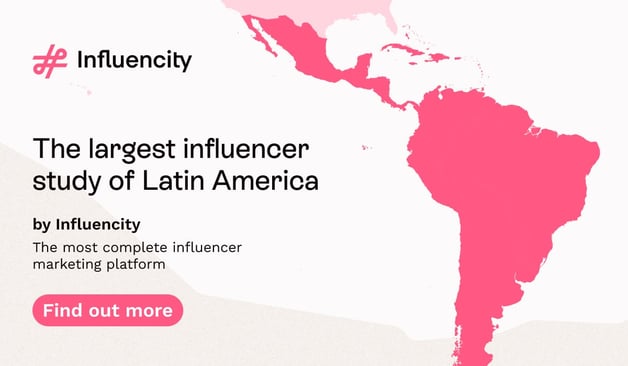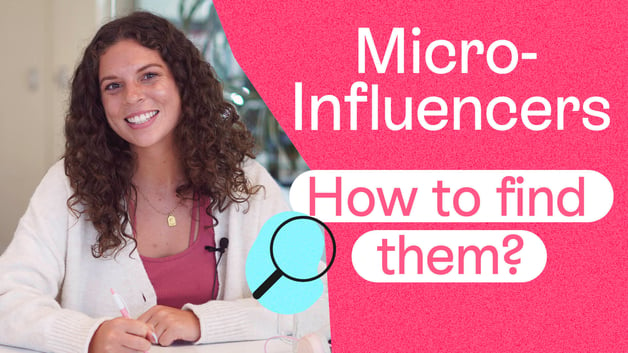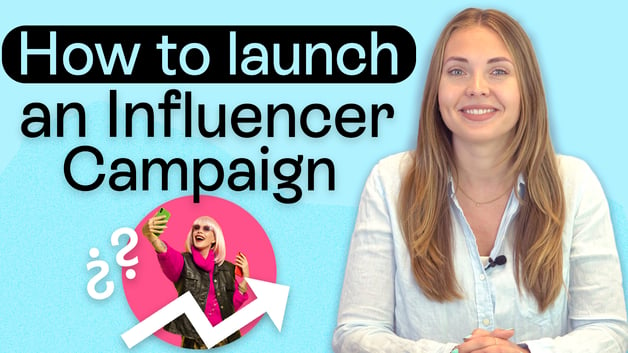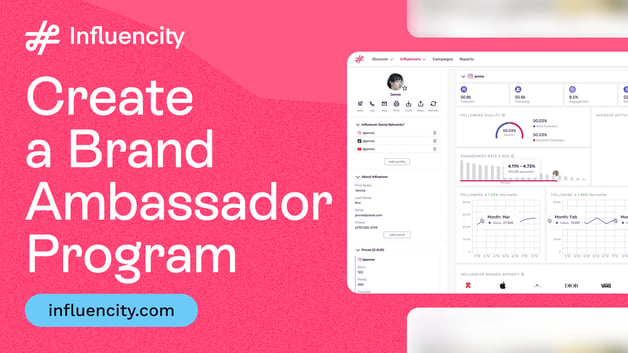Top Influencer Marketing Trends You Can't Afford to Miss in 2025
Influencer marketing is currently poised for significant shifts in 2025, with AI-driven personalization, voice search optimization (VSO), and sustainability trends, among others, taking center stage. To stay ahead of the curve and get the most from your marketing efforts, it's key to understand these emerging influencer marketing trends and adapt your strategies accordingly.
This article is all about the key influencer marketing trends that will shape the industry in 2025. We will share valuable insights into up-and-coming strategies and technologies so that you can effectively connect with your target audience, drive engagement, and achieve your marketing goals.
1. AI-Driven Personalization and Predictive Analytics
The first influencer marketing trend to watch out for next year is AI. Artificial intelligence (AI) is rapidly transforming the future of influencer marketing, providing brands with new tools and insights to enhance their campaigns and achieve greater success. By 2025, AI tools will be indispensable in influencer marketing. Brands will use AI not just to identify the best influencers but also to tailor campaigns with a deep understanding of audience preferences, engagement patterns, and behavioral data.
Burger King's "Million Dollar Whopper" campaign is a great example of using AI to make marketing more personal, interactive and fun. In this campaign, Burger King encouraged customers to get creative by designing their own Whopper using an AI-powered tool. People could pick their favorite ingredients, and the AI would whip up a unique image of their custom burger—even adding a personalized jingle for an extra touch.
To boost the campaign’s reach, Burger King partnered with influencers who shared their own creations, inviting their audiences to join in. This mix of AI and influencer engagement helped Burger King connect with fans in a new, memorable way, making each person feel like part of the brand story.
In addition, AI algorithms will enable more precise matching between brands and influencers based on niche interests, as well as anticipate what type of content will resonate most with target audiences. Predictive influencer analytics will allow marketers to forecast campaign outcomes with increasing accuracy, providing insights that guide more effective content creation and distribution strategies.
2. Voice Search Optimization (VSO)
The next big trend in influencer marketing to watch out for is voice search optimization (VSO). As voice assistants like Siri, Alexa, and Google Assistant become more woven into our daily lives, VSO is set to be a game-changer next year. Platforms like YouTube, Spotify, and Google Podcasts already prioritize voice search, making it easier for people to find content just by asking a question out loud.
To adapt, influencers should make their content more conversational, aligning with how people naturally ask questions. For example, instead of titling a video “My Skincare Routine,” a more voice-friendly title could be “Best Skincare Tips for Clear Skin.” This small tweak makes it easier for voice search algorithms to pick up.
Creating FAQ-style content that answers common questions directly can also boost visibility in voice searches. Plus, podcasts or audio clips on platforms like Spotify and Alexa Skills are great for voice search optimization since they’re already geared toward voice-first audiences. By keeping content simple, conversational, and question-based, influencers can make sure their work is easy to find and engage with as voice search continues to grow.
3. Sustainability and Social Responsibility
Another significant influencer marketing trend to watch out for is sustainability and corporate social responsibility (CSR). In 2025, brands will increasingly seek out influencers who are vocal about sustainability, diversity, and ethical practices. This shift is already visible in recent campaigns: for example, Patagonia has partnered with eco-conscious influencers to highlight its commitment to environmental causes, while brands like Ben & Jerry’s collaborate with influencers to promote social justice initiatives.
Ultimately, as younger generations like Gen Z continue to demand transparency and accountability, influencers who promote eco-friendly products and social justice causes will stand out from the crowd. Consumers want to connect with brands with a shared purpose, and influencers are a powerful platform for communicating these values authentically. Campaigns that emphasize environmental and social responsibility in 2025 will resonate deeply with these audiences, helping brands foster a stronger sense of loyalty and engagement.
4. Shoppable Live Streaming and Social Commerce
Social commerce is set to become a powerhouse in influencer marketing trend, as it blends entertainment with e-commerce to seamless, immersive shopping experiences. Platforms like Instagram, TikTok, and YouTube are already enhancing their live-streaming features to allow influencers to showcase products in real time, enabling viewers to purchase directly through integrated shopping tools. This trend is growing because it taps into the impulsive nature of shopping sparked by real-time interaction and immediacy.
By 2025, live-streamed shopping events are predicted to become a major revenue driver for brands. In fact, this trend is expected to account for 20% of global e-commerce sales within two years. And in the United States, live commerce sales are projected to grow by 36% by 2026, making up more than 5% of all e-commerce sales. So why is this format so successful? Put simply, it’s because, compared to traditional shopping, live-streamed events create a sense of immediacy and engagement that’s hard to match. Plus, in a live shopping event, consumers can see products in action, ask questions in real time, and receive immediate answers—all of which build trust and encourage spontaneous purchases.
For example, beauty brand Estée Lauder successfully tapped into this trend with live-streamed shopping events on Instagram. During these events, influencers and makeup artists demonstrated products, shared tips, and answered viewers' questions in real time. Consumers could then buy showcased products directly through integrated shopping links, creating a seamless, interactive experience. This strategy had a direct impact on the company’s bottom line, boosting digital sales by a whopping 60%.
5. Trust, Authenticity, and Transparency
Consumers are increasingly demanding genuine partnerships between brands and influencers, where brand values and influencer endorsements align seamlessly with the desires and preferences of their target audience. With the growing focus on trust and authenticity as an influencer marketing trend, consumers are quick to spot disingenuous or forced partnerships. Therefore, it is essential for brands to carefully vet potential influencers, ensuring they embody the company’s values and can authentically advocate for its products or services. This deeper alignment between brand and influencer not only fosters consumer loyalty but also leads to more effective, relatable campaigns that reflect consumer behavior patterns, showing that influencers genuinely believe in what they promote.
Influencers like Emma Chamberlain and Greta Thunberg are already championing these values. Emma Chamberlain, for example, chooses partnerships that align with her laid-back, environmentally-conscious lifestyle, collaborating with brands like Levi’s and promoting sustainable products. Greta Thunberg, a well-known climate activist, uses her platform to endorse only eco-friendly and socially responsible initiatives, setting a standard for values-based influencer marketing.
Moreover, transparency will remain a key pillar in maintaining consumer trust. As regulatory scrutiny increases, brands should clearly disclose paid partnerships and sponsored endorsements, ensuring full transparency in their collaborations. In an age where authenticity is paramount, failing to disclose paid partnerships can lead to consumer backlash and erosion of brand trust. Consumers appreciate openness and expect influencers to be forthright about their affiliations, allowing them to make informed purchasing decisions based on honest endorsements. By openly sharing these details, brands and influencers alike can build stronger, more credible relationships with their audiences, driving long-term engagement and trust.
6. Long-Term Influencer Partnerships
While one-off influencer campaigns may yield short-term results, building long-term partnerships with influencers will continue to lead to deeper brand advocacy and more sustainable engagement in 2025. These sustained partnerships ensure more consistent, authentic content that resonates with audiences. By working with the same influencers over time, brands cultivate deeper trust and familiarity among consumers, making the influencer’s endorsement more genuine. This strategy also benefits influencers, allowing them to create more integrated content that aligns with their personal brand while reinforcing their loyalty to the promoted brand
7. The Rise of Micro and Nano Influencers
Securing its position in the list of top influencer marketing trends for the second consecutive year is the rise of micro and nano influencers.
Micro and nano influencers—those with smaller followings but higher engagement rates—offer brands authentic and intimate connections with niche markets. Because their content feels more personal and trustworthy, they often drive higher engagement rates than larger influencers. For instance, nano-influencers (with fewer than 10,000 followers) have an average engagement rate of 4%, while macro-influencers (500,000 to 1 million followers) average around 1.3%.
As a result of these impressive stats, brands are increasing partnering with these influencers for targeted campaigns where genuine consumer trust is paramount, especially in industries like health, wellness, and eco-conscious living.
8. Influencers as Creative Directors
In 2025, influencers will increasingly take on roles beyond just social media content creators. Many will be involved in the creative direction of campaigns, collaborating closely with brands to shape overall strategy, visual identity, and messaging. Their deep understanding of social media trends and audience behavior makes them valuable partners in this capacity. As creative directors, influencers can ensure campaigns are both engaging and aligned with the latest influencer marketing trends, helping brands stay relevant and innovative.
Chiara Ferragni is a great example of this shift. After launching her career as a fashion influencer, Ferragni has evolved her role to include creative leadership, collaborating with high-end brands as well as promoting her own namesake fashion line. She has played a key part in defining her brand’s visual identity and strategic direction, using her insights to engage her audience authentically.
In the future, we’re likely to see influencers playing a much bigger role behind the scenes with brands—not just as faces of campaigns, but as active partners in creating them. They’ll be involved in everything from product design to brand messaging and marketing strategy. This gives brands the flexibility to stay up-to-date with social media trends and keep a pulse on what people really care about.
We’ll also see more influencers starting their own brands or teaming up with established ones, not just to endorse products but to help create them. In these partnerships, influencers might take on roles like creative director or even co-founder, guiding everything from the look of the product to how it’s marketed. This shift means influencers are no longer just promoting brands; they’re actually helping to build them, bringing their unique insights and authenticity into every step of the process.
9. Employee-Generated Content (EGC)
Employee-generated content (EGC), an extension of user-generated content (UGC), will become a strategic tool for brands in 2025, with companies leveraging their workforce as trusted brand advocates. Employees offer a level of authenticity that external influencers may struggle to match, providing unique behind-the-scenes insights into a company’s culture, products, and values. By turning employees into micro-influencers, brands humanize their messaging and build trust with consumers. EGC can range from day-in-the-life posts to product reviews, offering relatable and credible content that resonates with modern audiences seeking transparency.
Brands already benefitting from this trend include Adobe, who encourages its employees to share their personal work experiences and insights on platforms like LinkedIn, highlighting the company’s values through real employee stories. By empowering its team to become storytellers, Adobe showcases its culture of creativity, inclusivity, and innovation in a way that resonates deeply with audiences. Through initiatives like ‘Adobe Life,’ the company not only reinforces a relatable brand image but also boosts its standing as an employer of choice, building trust and engagement both within and outside of the company.
10. Metaverse and Virtual Influencers
The rise of the metaverse will revolutionize influencer marketing in 2025. Virtual influencers—digital personalities created through CGI, also known as AI-powered influencers—are becoming increasingly popular as an influencer marketing trend, especially within virtual worlds and gaming environments. These virtual personas, which include Lil Miquela and Noonoouri, already have millions of followers and offer brands a unique opportunity to leverage perfectly curated digital personalities. AI influencers are also more easily controlled by brands, reducing the risk of unpredictability that comes with human influencers. They can be customized to embody a brand’s values and aesthetics, operating in digital spaces such as the metaverse, where they interact with audiences 24/7. This shift will make AI influencers a growing part of marketing strategies for brands looking to maintain consistency and creative control.
Finally, brands are also tapping into the metaverse to create immersive experiences such as virtual events and branded spaces. This influencer marketing trend opens up new possibilities for engaging tech-savvy, younger audiences who are spending more time in virtual environments.
Final Reflections
As we look toward 2025, influencer marketing is clearly on the brink of big changes. Trends like AI-driven personalization, voice search, sustainability, and live-stream shopping are all reshaping how brands connect with people in a more meaningful way. These shifts aren’t just about technology—they’re about meeting consumers’ growing expectations for authenticity, convenience, and social responsibility.
So, which of these trends will really take off? Will brands lean more on AI to deliver highly personalized campaigns, or will sustainability and transparency become the driving force? Think about which of these directions fits your brand and audience best. Now’s the perfect time to explore these trends and decide how they can help you stay relevant, connect with people on a deeper level, and lead the way in influencer marketing’s next exciting chapter.
Tags:























%20and%20How%20Can%20They%20Benefit%20Your%20Brand%20article.jpg?length=628&name=What%20Are%20Key%20Opinion%20Leaders%20(KOL)%20and%20How%20Can%20They%20Benefit%20Your%20Brand%20article.jpg)








